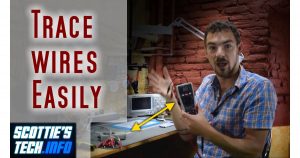4 December 2017 | Computers, Gizmos, How Does it Work?, Video |
 A few weeks ago, I published a video on how to get max speed from your USB 3 gizmos, which you can find here:
A few weeks ago, I published a video on how to get max speed from your USB 3 gizmos, which you can find here:
Slow copy speeds with USB 3? No problem!
Right, but if what about lowly USB 2 sticks? They’re far more prevalent than USB 3 sticks, and many of them are veeeery sloooow…
There are a few things to watch out for when buying your next USB stick.
And you don’t even need to be a technical genius!
(more…)
21 November 2017 | Computers, Programming, Video |
 Everyone knows that coders are weird people.
Everyone knows that coders are weird people.
Interrupt them, and you often encounter a rather strange and “interesting” reaction. Why is that?
Well, it’s all about what happens in your brain when you’re programming something. It’s probably one of the hardest things to focus on, at least for me.
There’s a reason why programmers tend to work late/early hours: fewer distractions!
Fortunately, there are a couple of tricks I have taught myself over the years that can make everyone much happier.
Even if you aren’t a coder, you can still benefit from these tips!
(more…)
7 November 2017 | Do-It-Yourself, Energy, Video |
 If you’ve ever accidentally chopped through a wire or electrical cable, you know how much fun it can be to try to repair it so that it stays waterproof, dust proof, weatherproof, etc.
If you’ve ever accidentally chopped through a wire or electrical cable, you know how much fun it can be to try to repair it so that it stays waterproof, dust proof, weatherproof, etc.
I recently had just such a fun experience myself. It turns out that there are quite a few nice products out there to make the splicing process WAAAAY easier.
Keep in mind that the type of splice you use depends greatly on the application – and even the type of wire (solid vs stranded).
A wire splice for an automotive-type application must be pretty strong, because vibration is obviously an issue.
An underground electrical cable doesn’t have to withstand vibration, but it definitely needs to be waterproof!
(more…)
24 October 2017 | Do-It-Yourself, Gizmos, Programming, Video |
 If you have a fuel or water tank that is either metal or colored plastic, you may have run into the same problem I had: How do you know when it’s empty?
If you have a fuel or water tank that is either metal or colored plastic, you may have run into the same problem I had: How do you know when it’s empty?
Mechanical level gauges are nice, but not always practical or even possible. So, I went on the hunt for an ultrasonic level sensor for my fuel tank.
Alas, what’s available on the market is too expensive, not very reliable, and often goofy in terms of features. So I decided to build my own!
This ultrasound fuel gauge can be built for around $33 using a breadboard, Arduino Uno, and one of 2 different ultrasonic transceiver modules designed for use with Arduino or Raspberry Pi boards.
(more…)
10 October 2017 | Computers, How Does it Work?, Video |
 USB is totally awesome, and USB 3.0+ is even more awesome.
USB is totally awesome, and USB 3.0+ is even more awesome.
With real-world data transfer rates of 400MB/s or more, copying files to external USB sticks and drives has never been more fun.
Only one problem, and I’ve noticed this A LOT: People are using USB3, but they’re sitting there putting up with relatively slow copy speeds from, say, a USB3 key.
It’s often rather difficult to achieve copy speeds in excess of a measley 40MB/s…
What gives?
(more…)
27 September 2017 | Do-It-Yourself, Gizmos, Video |
 There are many ways to trace a bunch of wires from point A to point B. Most of them kinda suck for one reason or another.
There are many ways to trace a bunch of wires from point A to point B. Most of them kinda suck for one reason or another.
Enter the Voltcraft LZG-1 / Extech CT40!
With this gizmo, you can trace up to 16 wires at once. The system uses a remote unit with 17 alligator clips (16 + one for the common/return conductor).
The remote unit sends a 5V pulse width modulated “square” wave to the main unit. Clip 1 is a ~52% duty cycle wave, and Clip 16 is about 98% duty cycle – at 32 Hz. This allows the main unit to distinguish between each wire reliably – as long as the resistance of each wire is less than 30kohms (which is pretty high).
The main unit also doubles as a DMM. Although it’s not the greatest digitial multimeter, it’s good enough for most applications.
(more…)
15 September 2017 | Do-It-Yourself, Video |
 Everyone likes to throw things away.
Everyone likes to throw things away.
But nobody likes the sight of an overflowing trash or recycling bin, and even fewer people like to take out the trash.
What if I were to tell you that with a simple Life Hack, you could save bin space and time?
What would you pay for such a hack? $19.99? $49.99? $199.99? $1,999,999.99?
Well, watch this vid for FREE… and BE AMAZED!
(more…)
5 September 2017 | Energy, How Does it Work?, Video |
 Extension cord reels, or rolly cords as I like to call them, are seriously handy.
Extension cord reels, or rolly cords as I like to call them, are seriously handy.
Nobody likes spending 30 minutes untangling a 50m extension cord.
Trouble is, usually we use them incorrectly!
It turns out you have to read the fine print: You can only use the full capacity of the reel if you fully unwind the rolly cord.
Oops!
(more…)
29 August 2017 | Do-It-Yourself, Energy, Video |
 First, remain calm. Second, watch this video!
First, remain calm. Second, watch this video!
A tripping circuit breaker or GFCI/RCD/differential breaker can be really annoying. It normally doesn’t happen.
When it does, the end result can be that you run around the room with your undies on your head, screaming like a wildperson.
Obviously, if your vacuum cleaner is charred and black and there’s a funny smell in the room, you’ve just figured out why the breaker tripped. But usually, the problem is a bit more subtle than that…
It turns out that with a bit of work, you can often cleverly narrow down the problem to one gizmo and save yourself some money – without setting anything on fire!
Yay!
(more…)
22 August 2017 | EEK!, How Does it Work?, Video |
 I usually see people freak out when they open the door of their circuit breaker panel. No more!
I usually see people freak out when they open the door of their circuit breaker panel. No more!
Note that I’m using European breakers and EU-type panel design as my example, so if you’re in North America or certain other countries, you’re not gonna see the same thing. Still, the general principles are the same.
Also keep in mind that there are far more gizmos that you might find in your panel: combined GFCI/circuit breakers, timers, and even a nifty gizmo that turns off circuit B when circuit A is energized.
Having said all that, if you just need a basic intro to breaker panels of all types, this is a good place to start! Then follow up with a book or an internet search for your specific location, and Bob’s your uncle.
(more…)
 A few weeks ago, I published a video on how to get max speed from your USB 3 gizmos, which you can find here:
A few weeks ago, I published a video on how to get max speed from your USB 3 gizmos, which you can find here:










Recent Comments